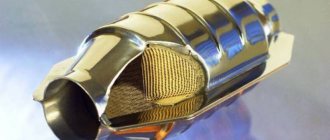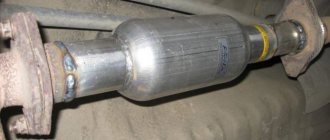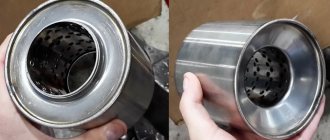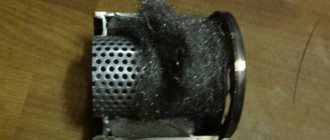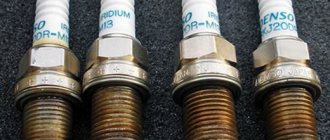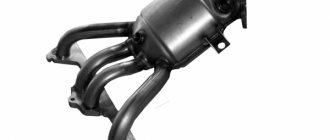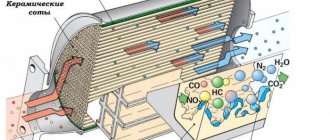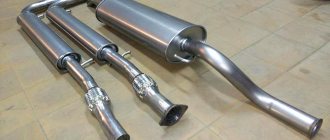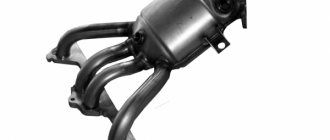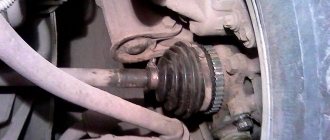Due to the tightening of International environmental requirements, a mandatory condition for the operation of vehicles is the installation of catalytic exhaust gas converters. But, this element belongs to the category of expensive, since the design of its filter unit contains alloys of precious metals, so if it fails, it is best to install a flame arrester instead of a catalyst with your own hands. The exhaust gas converter is very demanding on the quality of the fuel; during the operation of the vehicle, its cells become covered with an abundant layer of soot deposits, which reduce the throughput of the device and cause a decrease in engine power.
Important! Any catalyst is very sensitive to mechanical stress; even minor damage to its honeycombs can completely damage the part. It is quite problematic to restore the original functionality of the element, so most experienced auto mechanics suggest making a flame arrester from a used catalyst.
When the neutralizer honeycombs are contaminated, there is a significant increase in pressure inside the exhaust system, which causes a decrease in the acceleration dynamics of the vehicle and a significant increase in fuel consumption. The complexity of the problem lies in the fact that the exhaust system of most vehicle models contains several of these elements.
How much does a fire extinguisher cost?
You can find flame arresters from leading manufacturers in the catalog on our website using convenient navigation.
You can also drive up to one of our car services, where they will select the flame arrester of the required model for you. Many car owners cannot decide what is better to put in their car - a catalyst or a flame arrester. Also often concerned is the issue of the legality of installing a flame arrester instead of a catalyst and the environmental standards established by the Government of the Russian Federation for the content of CO and CH in car exhaust gases (the possibility of legally passing exhaust toxicity control).
The use of flame arresters is permitted in the Russian Federation. CO/CH standards in Russia are significantly softer compared to European ones. Any car without a catalyst with a properly functioning engine easily meets the Russian CO/CH standard.
By its design, a flame arrester is a type of resonator. This element of the car's exhaust system primarily encounters the flow of exhaust gases emanating from the engine and therefore it must be durable and heat-resistant
Indeed, the speed and temperature of the engine exhaust gases are quite high and it is very important to cool and slow them down as much as possible before they enter the resonator
To reduce the cost of repairs, many car repair shops independently manufacture flame arresters based on the old catalyst housing. The technology for creating a homemade product usually looks like this:
- The catalyst body is cut and the remaining ceramics are removed from it;
- A perforated pipe is placed along the body;
- The gap between the pipe and the body is laid with sound-absorbing material, usually basalt wool.
Homemade flame arresters often do not dampen noise well, and the cheap filler used in their manufacture burns out after the first year of operation of the machine. As a result, a rattling sound appears, similar to the well-known sound of a Volga car engine running.
Factory products of the AWG and MG-Race brands are free from all of the above listed shortcomings. They have passed the necessary certification and time-tested in Russian road operating conditions.
If you have an old car with a rather worn-out internal combustion engine, then installing a new catalyst on it is unprofitable. In this case, it is impossible to avoid engine oil getting into the catalyst, and this significantly reduces its service life. Failures in the ignition system are also extremely dangerous for the converter. Unburnt gasoline begins to accumulate in the catalyst, where it subsequently burns, destroying it. In all such cases, it is more advisable to use flame arresters, which compare favorably in price and reliability.
How to repair a muffler
If your car's muffler requires repair or complete replacement, it is not recommended to do this work yourself, since there is a high risk that you will only worsen the condition of the exhaust system, and possibly the entire vehicle as a whole. In order to prevent such a situation, contact only specialized car services. In our car service center, qualified specialists with the necessary competence in the field of working with exhaust systems will competently diagnose the exhaust system of your car, and, if necessary, repair or install a new muffler in the shortest possible time.
If you encounter any malfunction in the exhaust system and you need to diagnose it, repair it or replace the muffler, then our salon specialists will be happy to help you with this, since we carry out all types of this work!
When developing most modern cars, technical solutions are widely used in their design, the main task of which is to ensure maximum comfort for the driver and passengers of the vehicle. In addition, a car that comes off the assembly line today simply must be environmentally friendly: it pollutes the air minimally and creates a low level of noise when driving. Environmental standards are especially strict in Europe and the United States, but Russia is gradually moving in the same direction.
Reducing the amount of harmful exhaust into the atmosphere and the noise level of the machine is achieved through the design of the exhaust system and the operation of the catalyst, whose task is to neutralize the main toxic gases generated during engine operation. This is a necessary part of any car; in the West, a car cannot be operated without a catalyst, but in Russia the situation is somewhat different. The fact is that the catalyst is quite expensive (precious metals are used in its design), therefore, after the end of the service life of this element, various cheaper alternatives are sought for it.
One of the most common ways to replace a catalyst is to install a flame arrester in the vehicle's exhaust system. Currently, you can easily find a flame arrester for any type of engine; many well-known foreign and domestic manufacturers of automobile parts are engaged in their production. The most common is the so-called universal flame arrester; they are manufactured by such well-known brands as “Platinik”, “Asmet”, “Ferroz” (Poland), “Asso” (Italy), “Simons” (Finland), “Walker”, “ Universal" (Estonia), "Marmittesara" (Italy).
Advantages of replacing a catalyst with a flame arrester
Installing a towbar socket on a Chevrolet Niva
This option seems very attractive, but has some nuances. Not every service station will do this efficiently.
The fact is that not every replacement of a catalyst with a flame arrester ends up being successful. Often an installed spare part breaks down within the first months of use, and even more often it does not perform its intended functions.
Fact! Often, as a result of replacing the catalyst with a flame arrester, interruptions in engine operation occur. This is not due to the new part, but to the old ECU settings. The fact is that many modern cars are equipped with exhaust cleanliness sensors. And if the catalyst contains a special filter, then the flame arrester does not. The sensors are going crazy. The ECU system does not know that you installed a flame arrester instead of a catalyst: it decides that the latter is broken and blocks the engine. To drive safely, you need to reflash the ECU.
Only the best qualified craftsmen can properly install a flame arrester in place of a catalytic converter. How to find them? We know such people - they work at the Muffler Master.
Why should we replace the catalyst with a flame arrester?
- Relatively inexpensive. At Master of Silencers you will pay from 2500 to 5500 rubles for the service.
- Fast. Usually the procedure takes no more than an hour.
- We know exactly how and what kind of flame arrester you need to install - and whether it can be done at all. After replacement, you will not be bothered by muffler malfunctions for a long time.
- Qualitatively. We order flame arresters from the most reliable manufacturers. Our craftsmen know exactly how to ensure that the flame arrester serves correctly and does not cause any trouble.
- For a long time. We provide a guarantee of 6 months, which indicates the high efficiency of the replacement. Our new flame arrester will last for at least several years.
Make an appointment to have your car repaired by calling the phone number listed on the website, or use.
Why is one thing replaced by another?
The catalyst can become unusable simply by exhausting its resource. This does not happen with new cars, but if the car was bought second-hand and managed to travel 150 thousand km or more, it means that the catalyst in it is seriously worn out. And since it is impossible to clean or restore it, there is only one way out: replacing it with a flame arrester.
High mileage is not the only reason for wear of the standard catalyst. It can also become unusable due to bad fuel. Unscrupulous sellers, trying to increase the octane number of their low-quality gasoline, add additives containing lead to it. Exhaust gases from such fuel cause overheating and subsequent melting of the catalyst sections.
Finally, flame arresters are installed in cars due to the high cost of branded catalysts. This is the most popular reason, especially now, when the price of catalysts has become simply prohibitive and can vary from 50 to 250 thousand rubles.
How to properly and competently remove a catalyst
Replacing the catalyst with a flame arrester
Many people ask the question “Is it possible to remove the catalyst yourself?” You can, if you have the necessary tool at hand, and not only a “cutting” or “welding” one, but also a full-fledged software package designed to disable (or deceive) the second lambda probe and the diagnostic function.
The Mastery service station, which specializes in solving any problems with the exhaust system, has everything necessary to remove the catalyst. With the help of its specialists, we will see all the stages of proper catalyst removal, including installing a flame arrester and disabling the corresponding errors and catalyst diagnostic functions.
What happens if the catalyst is completely removed from the car?
This issue is almost a priority for most vehicle owners. Many people believe that the solution to all problems will be to install a direct flow instead of a used converter. But, in addition to the fact that this will lead to a significant increase in noise, the exhaust gases will constantly be at a high temperature, and this negatively affects the operation of other components of the car. On many modern cars, a special sensor is installed along with the catalytic converter, the removal of which will certainly cause an error signal to appear. Before dismantling the neutralizer and sensor, it is best to consult with a specialist who will help in solving this problem, since this will require an integrated approach.
It is worth noting that in accordance with the International Euro-4 standard, a special lambda probe is installed on vehicles, without which the power unit will begin to operate incorrectly, and an error message will constantly light up on the display. To ensure correct operation of the engine, you will need to install a special “trick” and reflash the car’s ECU. As you can see, removing a catalytic converter from a vehicle exhaust system without consequences is not so easy.
How long does a flame extinguisher last? Pros and cons of the device
Rust removalLearning to remove rust from a car on your own
Flame arrestors installed separately usually operate successfully for five to ten years. Collective flame arresters last less (up to five years), since they have to work in the “hottest” conditions. The lifespan of this car part can be even longer if it is made by a reputable company using high-quality materials. It is also necessary to take into account operating conditions, vehicle characteristics and mechanical effects on the product.
Now a few words about the pros and cons of installing a flame arrester. The most significant advantage is the price of this device. By installing a budget flame arrester instead of an expensive catalyst, you can save a lot of money. The flame arrester is less demanding on fuel quality compared to the catalyst - this is its second absolute advantage. Since the quality of gasoline at our gas stations often leaves much to be desired, this advantage is quite significant. In addition, the flame arrester slightly increases engine power, since it has a direct-flow structure (and not a honeycomb, like a catalyst).
Of course, the flame arrester also has disadvantages (where would we be without them). The main one is environmental pollution. Without a catalyst, all outgoing exhaust gases go outside without any purification. So, if you care about clean air on the planet, then it is better to install a new catalyst.
To install a flame arrester, electric or gas welding is required, so doing it yourself is quite problematic. The installation of a manifold and a free-standing flame arrester is different because in the first case the exhaust manifold must be removed. However, it is hardly worth saving on this procedure: installing a collector flame arrester costs 6-8 thousand rubles, and a free-standing one costs 3-5 thousand rubles.
Advantages and disadvantages
Most often, car enthusiasts decide to install a homemade flame arrester instead of a catalyst due to the high cost of the latter. For a domestic car, the price of this element is about 30 thousand, and for a foreign car it is estimated at 50 - 100 thousand. However, it should be remembered that replacing the catalyst with a flame arrester entails several negative consequences:
- the amount of toxic exhaust increases significantly, which does not meet modern environmental standards;
- the service life of the muffler and resonator is reduced;
- In order for the power plant to work well, you will have to make adjustments to the oxygen sensor settings or reprogram the controller.
Car enthusiasts should remember that the electronic unit controls the process of creating the air-fuel mixture, based on the readings of several sensors, including oxygen. If you make a flame arrester with your own hands from a catalyst, then due to incorrect information the controller will prepare a poor-quality mixture and this will lead to a significant increase in fuel consumption.
However, making a stronger with your own hands and its subsequent installation on the car can give the car enthusiast several bonuses:
- the flame arrester creates less resistance to smoke upon exit, which will save fuel and somewhat improve the operating conditions of the power plant;
- motor power can increase by about 5 - 7%;
- If you drive into an area overgrown with dry vegetation in the summer, the risk of a fire will be minimal.
The principle of operation of the flame arrester
During operation, the flame arrester receives exhaust gases that enter the exhaust system, processes them and removes them. At the exit, the temperature of the gases becomes significantly lower, and their speed drops significantly.
In addition, the flame arrester breaks the primary flow of gases that come from the collector. This approach is used for the purpose of stable operation of the main resonator.
In addition, the flame arrester mixes all the unstable flows ufpjd from the cylinders into one stable flow. Thanks to the design of the body of the part itself, the flame arrester significantly reduces the level of noise that appears inside it due to the beating of gases.
How does a flame arrester work and what device does it have?
The design of the flame arrester is the same as that of the resonator. Inside there are traps whose task is to reduce the temperature of the gas stream. The body of the product is two-layer. The space between the layers is filled with a special filler that is sufficiently resistant to elevated temperatures. The design suppresses characteristic ringing sounds. Sound waves are absorbed by special material placed inside the system.
In the production of the element, high quality metal with good resistance to corrosion processes is used. The flame arrester body cannot be affected by chemicals, salt, moisture or dirt. Aluminum is used in the manufacture of some models, which significantly increases the service life of the product. Such components are more expensive.
Some car enthusiasts use homemade devices, hollowing out the factory filling and installing their own system. The simplest version of the device is this: a metal pipe with a large number of holes drilled in it. In the internal part of the flame arrester there are several partitions, the task of which is to extinguish the flow rate of hot gas. The body is welded on both sides, there are only 2 holes - for the entry and exit of gases.
The installation of the device is carried out according to a certain algorithm. Its size depends on the volume of the power unit and the strength of the exhaust flow. If you choose an inappropriately sized damper, there is a risk of not getting any results.
Instructions for making a flame arrester with your own hands
So let's move on to the manufacturing procedure, for this we need two iron pipes, one with a diameter equal to the diameter of the exhaust pipe of the muffler, the second with a larger diameter and steel mesh brushes for washing dishes. On a pipe equal to the muffler pipe, we cut out (using gas welding or a drill) holes with a diameter of 3 mm along the entire circle and length. Then we insert this pipe in the center into a pipe of larger diameter and weld it on one side.
Then we stretch the mesh brushes in a circle in the form of a ring, put them on a pipe of a smaller diameter and push them tightly with a metal strip until it rests on the closed end of a pipe of a larger diameter. We continue this procedure until the last mesh brush reaches the free end of a larger diameter pipe. It took me 26 mesh brushes to fill the empty space.
After this, we bend the ends of the pipe of larger diameter, pre-cut with a grinder, and scald them in a circle. This procedure helps to avoid unnecessary ringing noises from the flame arrester during engine operation. For beauty, you can paint it with silver spray paint. Now, with peace of mind, we cut out the catalyst and weld the manufactured flame arrester in its place.
PS A flame arrester instead of a catalyst can be installed on cars with Euro standard 2. On cars with Euro standard above 2, there is an oxygen sensor lambda probe after the catalyst and removing it can lead to an error in the engine control unit, which in turn will increase fuel consumption and worsen dynamics car.
Alternatively, you can make a flame arrester with your own hands on a VAZ
We take an old resonator, it is 2 years old and 45t.km. For the flame arrester body we needed an old muffler. We cut the muffler into metal.
The outer casing of the drain muffler is 2 layers of metal - 0.6 mm on the outside; from the inside - 0.8 mm., by the way, well preserved, slight corrosion between these two layers of metal. Next, look carefully at the photo, everything is clear.
inside…
inside…
The outer diameter of the cut pipe is 80 mm, thickness 1.5 mm, will be used for the flame arrester body.
We use the remaining piece for the end walls, then, due to the reluctance to cut the resonator pipe in half due to the further complexity of the joining, we did this: the flame arrester body was welded, cut lengthwise:
We put the halves on, scald them, then on the outside with a second layer we weld a 0.8 mm thick shirt onto the flanges of the end walls with a gap between the shirts of about 5 mm, the flanges are visible in the previous photos, the result:
On the end walls there is also an additional layer of metal 0.8 mm
then on the flame arrester body there is a noise-sound-heat insulator - a cover with flanges with asbestos fabric inside
We cook the lining from the bottom of the car
Similarly, on the bottom side there is a lining with asbestos for the resonator, we cook:
By the way, there is a decent stench when paraffins come out of asbestos... from heating. Now we clean with a cleaning disc and a metal brush
We degrease and paint with thermal paint (otherwise it will quickly corrode during welding, all welded seams should be thoroughly cleaned with a brush) thermal paint is stated to reach 538 degrees Celsius, we’ll see... By the way, one can was enough to paint three layers, there was one extra can left...
Now in a week I’ll install it somewhere, now I won’t have time, the plans are to remove the old (new) resonator, remove the thermal shields from the bottom, clean and cover the barrier with 2 layers of vibration-mastic, reassemble it in place, and by the way, reinforced suspension cushions of the resonator (weight -something has increased), I hope the metallic sound will go away, or it will become much less, in any case, I will approach the assessment of changes carefully and as objectively as possible, otherwise I somehow got into trouble with the SAAB... The original muffler is straight-through, and these Saab ones are for turbo- engines, the turbine itself dampens the sound quite well and the task there is to remove the exhaust as easily as possible. By the way, between the wall of the original resonator and the outer pipe 1.5 mm thick, I was afraid to shove stainless steel dish brushes, in case they start rubbing against vibrations and pressure and pour into the exhaust or even into the engine, write comments and we’ll discuss
Yes, I almost forgot - the stock silencer has stainless steel end walls and an exhaust tip, a mysterious Russian soul, if the 2 outer skins were made of stainless steel, it would be an indestructible silencer because Everything inside is practically new.
Source
Motorist's benefit
features and types of design
We make podiums for car speakers with our own hands.
The flame arrester can be classified:
1. According to the noise suppression method, there are two types:
- active. The effect is based on sound absorption. The main element of the active flame arrester is a special filler. For these
purposes, a fiber element of synthetic or basalt type is used.
The disadvantage of the design is the inability to withstand high temperature emissions from the front of the muffler. Along with this,
burnout occurs within 2-3 months (if a stainless steel mesh is installed) and within 10-15 days if there is no protection at all. - passive. With this design, the product reflects sound waves. Passive flame arresters are more reliable. They have two layers, which allows the inner “casing” to dampen external vibrations. Without this, the casing of the device will ring loudly at the first impact.
The outer layer must be made of a material that can withstand the action of liquids and is resistant to rust. If the quality of the material is poor, the action of liquids, acidic solutions from the road and changes in temperature conditions destroy the equipment. Based on this, the ideal option for a flame arrester is not aluminized, but heat-resistant stainless steel.
The requirements for flame arrester elements installed on the inside are not so stringent. The circumstance is the absence of negative condensation and moisture effects.
2. By design highlights:
- straight-through;
- with diffuser. Products with a diffuser are seen less often. The main difference is the presence of a special pipe welded to the middle part of the product. Its purpose is to move it and create a flow into the flame arrester casing.
Another parameter that matters is the quantity of the product. If the quantity is small, then pressing the accelerator leads to the appearance of strong rattling in the muffler area. If the muffler itself and the resonator have a direct-flow principle of operation, then there will be fewer problems with rattling (excessive noise).
Video: Replacing the catalyst with a flame arrester. cons and pros. Just something complicated
Using a flame arrester when tuning
When installing a tuning exhaust system of the direct-flow type, the sound requirements are somewhat different: you need a thoroughbred, loud sound with a predominance of low frequencies. If you are interested in high-quality video content with mature women, we advise you to visit our website and evaluate what exactly we have prepared for you. It’s not for nothing that there are videos here in which a mature woman gave doggy style https://zrelochki.com/doggystyle to her lover and allowed her to film it all on camera. You won’t find such videos on the Internet anymore, so we advise you to bookmark the link for the future. You'll definitely want to rewatch this. Therefore, the direct-flow flame arrester used for tuning can be simpler in design. It must be reliable, have a two-layer casing and a flow area corresponding to the motor power.
Catalytic converters compress the exhaust too much. When exhaust gases pass through the catalysts, there is a strong decrease in the throughput capabilities of the route. Flame arrestors are free from this drawback and allow you to normalize the average gas pressure.
The appearance of the flame arrester is also important. The ability to use different colors and types of paints allows you to tailor the design of the flame arrester to the style of the car.
Unfortunately, even well-known brands for the most part do not have direct-flow resonators with a two-layer casing, since in the West control over the purity of exhaust gases is much stricter. Therefore, low-resistance metal-based catalysts are popular there. They consider it acceptable to leave a standard catalyst behind the tuned manifold. Lack of interest in parts that can be used instead of a catalyst is considered the main reason why Western manufacturers do not produce any parts of this kind.
Difference in design
Now we can distinguish several main designs by which flame arresters are made:
- Straight . Essentially, this is a pipe driven into a housing with a certain non-combustible material. That is, here the gases encounter practically no resistance. Often these options are equipped with main “dampers”.
- Funnel . This is when the pipe tapers, that is, the diameter at the top (at the beginning) is larger than the diameter at the bottom (at the end). Here, gas pressure acts on the stacks, releasing some of the gases.
- Spiral type. A spiral is installed inside the pipe, along which the gases seem to descend from the inlet to the outlet.
- Resonator type. Here the device is very similar to a resonator. That is, there are several chambers inside and pipes that are not in one line. Thus, it turns out that gases meet the walls, give up some energy, and only then pass on.
I would also like to note that the wall of any high-quality flame arrester must be double, with a “lining” made of a special non-flammable material. That is, it turns out like a pie, it is done in order to avoid the ringing sound under the bottom of your car.
How to make a flame arrester with your own hands
As we already know, removing the catalyst (cutting it out of the exhaust system) is not difficult. At the same time, the characteristics of the car will not suffer from this. The only thing that will change is the environmental component. There will be more harmful substances in the exhaust gases of the car due to the lack of additional cleaning.
What types of flame arresters exist, what are their features? Is it possible to build a flame arrester with your own hands? Let's consider these points in more detail.
Removing the catalyst without installing a flame arrester - is it possible?
Many car owners are interested in whether it is possible to remove the catalyst and not install a flame arrester in its place. Theoretically, this is possible. But you should be prepared for a number of problems, namely:
- Reduced muffler service life. This is explained by the fact that the catalytic converter (like the flame arrester) retains and cools the exhaust gases. Further, the already cooled exhaust gases are directed to the muffler and no longer cause harm to the product (“burning” of the metal does not occur). If the catalyst and flame arrester are missing, then the hot stream of exhaust gases flows through the pipes to the muffler. For this reason, the resonator “burns out” faster, and the device itself requires repair or replacement.
- The exhaust volume increases. Many people believe that when the catalyst is removed (without replacing it with a flame arrester), the engine volume increases and resembles the sound of a racing car. Not at all. According to statistics, the catalyst removes only 5-7 percent of sound. This means that the engine becomes louder, but not significantly. Only particularly picky drivers will feel discomfort.
It is for these reasons that it is worth buying or making a flame arrester and installing it instead of the dismantled catalyst.
What types of flame arresters are there?
During the selection process, it is important to know about the types of devices available on the market. Today there are two types of flame arresters:
- Collector. Already by the name you can understand that such devices are mounted in close proximity to the collector. This type of product is used most often and is installed on 70 percent of cars.
- Trunk. The main feature of the flame arrester is its installation in the central part of the pipe. This type of device is suitable for cars with turbocharged engines. It's easy to explain. Engines with a turbine have special requirements: the pressure of the exhaust gases must be maximum. For this reason, a flame arrester is not installed on the exhaust manifold.
The mentioned types of devices also differ in design. Thus, the collector flame arrester has a simpler design, while the main unit has a more complex design.
How does a flame arrester work?
Flame arrestors come in completely different designs. Here's what a classic (“direct”) flame arrester looks like:
- Select a straight tube and drill a lot of holes in it (that is, make the product perforated).
- You make the body. It is desirable that the latter be done using two sheets of metal and a spacer (installed between the layers). Next, roll the blanks into an ellipse or cylinder.
- Insert a previously prepared tube with holes into the finished housing, and hammer non-flammable material into the spaces between them (basalt wool will do).
- Weld the upper part of the outer casing and leave only the pipe.
Video: DIY flame arrester for Ford Focus 2
If the video does not show, refresh the page or ” style=”color:#CC3333″>click here
That's all. Essentially, you made a fire extinguisher yourself. After its installation, exhaust gases will enter the pipe, pass through the holes made and remain in the material. At the same time, the flame arrester absorbs some of the extraneous sound and cools the exhaust gases.
Is it possible to make the device yourself?
From the considered algorithm it is clear that it is possible to make a flame arrester in a garage. In this case, the finished device is installed in place of the previously knocked out catalyst. But keep in mind that, to extend the service life of the flame arrester, use stainless steel as the starting material. The main advantage of this material is its resistance to corrosion and lack of reaction to road chemicals.
If you make a flame arrester with your own hands, using ordinary steel, the product is unlikely to last more than five years (it will be destroyed by corrosion). If you give preference to stainless steel, then the service life doubles or even more. The only difficulty lies in the special technology for welding such metal.
Preliminary nuances
Let's start with the simple concept of a catalyst, which for some reason they want to replace with their own hands or the hands of a craftsman with a flame arrester. The catalyst is a device that is part of the exhaust system. It serves to purify gases produced during fuel combustion from all kinds of impurities.
But if this device breaks down or becomes dirty, returning it to its original level of performance is not so easy. In fact, car owners make one of 2 decisions. In the first case, they buy a new part and install it in place of the old one. The second option is to replace the catalyst with a device called a flame arrester. He's a strongman. At the same time, there is a lot of controversy and talk around the second method. Motorists sometimes do not understand why they should do this, what such modification will do and whether it will worsen the performance of the car.
Car enthusiasts are divided into 2 camps. Some argue that installing a stronger is an excellent tuning solution. Others are confident that such modernization will only cause harm.
But how dangerous would it actually be to remove the catalyst? And if this is harmful, then why do service stations actively offer this service in Yekaterinburg, St. Petersburg, cities such as Moscow, Voronezh, Volgograd and other parts of the country? And the price isn't that bad.
It's all about the myths that have formed around flame arresters. They look like this:
- the motor begins to quickly fail;
- the muffler breaks down;
- the engine is very noisy;
- exhaust gases become more dangerous in their composition;
- great harm is caused to nature;
- in the cabin you can be poisoned by the exhaust;
- the engine consumes fuel in huge quantities;
- motor life is reduced significantly;
- the exhaust system lasts quite a bit, etc.
But it was not in vain that I focused on the fact that these are myths. Most of them are very far from the truth.
What to choose: flame arrester or catalyst
Almost the most popular work with the exhaust system on modern cars is replacing the catalyst with a flame arrester.
This procedure causes a lot of controversy as to how safe it is and whether the game is worth the candle. Let's consider the following points:
— Catalyst content
— Flame arrestor content
- Process
— Results of replacement
Catalyst
The internal filling of the catalyst is multilayer and consists of several fractions. One of the main elements is a part consisting of honeycombs and coated with platinum group metals. This is necessary to burn out harmful substances from the exhaust gases, thereby cleaning the part that goes into the environment.
Thanks to total control, performed using two oxygen sensors installed on both sides and regulating the readings of both the incoming mixture and the outgoing purified one. If the readings differ from the specified parameters, then the operation of the power unit, and in particular its fuel system, will be adjusted or stopped.
Flame arrestor
Flame arrestor, there are 2 types. Intracollector and main. In addition, they are divided by type of production, into factory-made and handicraft-made.
However, the meaning of their use does not change, as does the interior decoration. When manufactured using a homemade method, the flame arrester is a barrel similar in size to the catalyst, inside of which there is an elbow, with holes drilled around the perimeter.
In simple terms, a flame arrester is not an alternative to a neutralizer in its full sense, but is often a successor. After installation, the control system is reprogrammed to a lower emission class in order to eliminate errors.
Replacement
When replacing one part with another, there are several methods. Provided that the catalyst is in the collector, there is a method in which the filling of the collector is removed in a barbaric manner by knocking it out.
Then, using a homemade method or selecting the required factory one, the flame arrester element is inserted inside and the integrity of the collector surface is restored. With this design, there may be a little more noise than usual, but the problem will go away after flashing the control unit.
The second method involves a similar procedure, with the catalyst located between the manifold and the middle part of the muffler. To pierce and remove the insides of the neutralizer, they use brute force and improvised means. In the end, you need to reflash the system for a lower fuel class and emission class.
The third option is the simplest and does not require much effort. The factory flame arrester is made in the form of a can, so using the necessary dismantling method, be it cutting off the old one or simply unscrewing the flanges, we remove the failed catalyst.
Bottom line
The cheapness and availability of this method are the main criteria for selection. If the flame arrester is made in a homemade way, then its main negative quality will be louder operation and a decreasing service life of the entire exhaust system.
The hot mixture will now reach the exhaust pipes faster, and accordingly, its wear will be increased.
When installing a factory flame arrester, the exhaust sound will not change one iota. It should also be noted that installing such a system, in principle, changes the factory settings and lowers the car’s requirements for both environmental friendliness of the exhaust and a higher octane number. Therefore, you can save money and use cheaper fuel.
To summarize, we note that such an operation has enough pros and cons; whether to do it or not is up to your locksmith and you personally to decide. And do not forget that replacing the catalyst with a flame arrester is required in specialized services that have not only experience in such repairs, but also qualified automobile mechanics.
Automotive catalyst: purpose, principle of operation, types
The catalyst is located in the exhaust system and performs the function of removing and pre-purifying gases.
Inside the device, toxins are converted through chemical reactions into less harmful substances. This treatment results in minimizing environmental pollution.
The catalyst is activated as a result of heating, so it does not function when the engine is cold started. It operates in close symbiosis with oxygen detectors.
Thanks to them, the optimal ratio of the composition of the mixture consisting of gasoline and air is formed, which, depending on this, becomes leaner and enriched.
The detectors, guided by the available readings, control the catalyst located between the muffler and the engine.
It is provided to be covered with a special screen, since as a result of strong heating it becomes very hot. The unit can be in several states:
1.Working. Characterized by the normal condition of the car. The error light does not light up when the engine starts.
2. Half working. Traction periodically disappears, the engine becomes less responsive at high speeds.
The car starts worse when started hot and it becomes necessary to repeatedly drive the starter.
When you press the gas pedal, the tachometer needle cannot overcome the 4 mark, and fuel consumption increases.
3. Non-working. It is in such a situation that the catalyst must be replaced, since the vehicle begins to stall immediately after starting the engine or does not start at all.
Attention! You can identify a non-working condition by placing your hand in the pipe when the vehicle is started, checking the release of gases; if this does not happen, then the system does not function.
There are several types of neutralizers:
- tripartite;
- for lean fuel mixtures;
- bilateral;
- for diesel engines.
Double-sided models can neutralize unburned gasoline and carbon monoxide. Three-way modifications additionally break down nitric oxide, releasing oxygen from it. Diesel analogues prevent soot emissions.
We remove the catalyst and install a flame arrester. Video:
Installation of the blende
Decoys can be mechanical or electronic.
The mechanical blende is essentially a mini-catalyst that is screwed in together with the oxygen sensor. It is easy to install, but, unfortunately, it is not suitable for all cars.
This type of lambda probe also has its own service life - on average up to 20 thousand km. mileage
Electronic decoy is a full-fledged emulator of sensor signals with a microcontroller. It acts either to average the readings of a real “oxygen tank”, or to synchronize the readings with the first sensor.
Installing an electronic emulator
Electronic deception is more universal in the sense that it can be made for almost any car model. True, it also has more disadvantages: it is not possible to take into account all engine operating modes, so deviations in its operation are inevitable. Well, since this is electronics, problems with the emulator itself are inevitable.
Chip tuning and software shutdown of the catalyst
Chip tuning or ECU flashing - replacing the factory program of the control unit with a modified version. To programmatically remove the catalyst, the factory firmware disables control of the device using oxygen sensors, and adjusts fuel maps and torque models. Euro-2 firmware disables the second oxygen sensor and allows you to cut out the rear catalyst (bank 2), Euro-0 firmware disables the first lambda probe and allows you to remove the catalyst in the manifold (bank 1).
Disabling the catalyst in the ECU is a mandatory step when removing the device. This allows you to configure the engine to operate correctly and eliminate errors forever. Instead of a catalyst, a flame arrester or stronger is usually installed. You can further tune the exhaust system by installing a spider.
Installed flame arrester and new corrugation on Hyundai Tucson 2.7
An additional advantage of chip tuning will be improved gas pedal response, increased power and torque. This way you will achieve several goals at once: save on replacement costs and significantly improve the dynamics of the car.
How to disable and remove the catalyst on the Kia Sorento 3.3:
Stronger instead of catalyst
A stronger or flame arrester is one of the types of resonators, although in functionality it is also similar to a catalyst, but of a simpler design. It also serves to process the primary exhaust gas streams from the crankcase, which then enter the main exhaust system resonator.
Stronger slows down the flow of exhaust gas, partially cools it and reduces noise from engine operation, but, unlike a catalyst, does not oxidize harmful exhaust gases. Moreover, thanks to the simplified structure of the stronger, the exhaust gases receive less resistance on their path, which increases engine power and vehicle dynamics. This is why installing a stronger instead of a catalyst is extremely popular among auto tuning enthusiasts. But, still, the main advantage of replacing the catalyst with a stronger is its affordable price and versatility!
On the Ukrainian automotive spare parts market you can find many different models of strongers, but not all of them are suitable for installation instead of a catalyst; or rather, any can be installed, but some of them will fail very soon. Here's why: Not all fire extinguishers are created equal.
As is already known, if a stronger is installed instead of a catalyst, then it will be exposed to a fast and extremely hot flow of exhaust gases. Therefore, increased demands are placed on the quality of the flame arrester. The main requirement for a quality part is a double-layer flame arrester body made of high-quality steel with an anti-corrosion coating, for example strongers made of aluminized steel.
The standard of quality is German strongers, the price of which is in the upper range. A good alternative is the Polish “AWG Polonez” strongers, the price of which is significantly lower, and the quality is not inferior to branded German products.
Very often you can come across cheap Chinese strongers that are made of low quality metal and soon burn out. There are also cases of installing conventional single-layer resonators instead of a catalyst, but such substitutes are not capable of performing the functions of a flame arrester and also do not last long.
A separate list should be given to our Ukrainian strongers of the Demi Motors brand. Let’s not praise ourselves, but our products are absolutely not inferior in quality to the same Polish or German ones and are an order of magnitude higher quality than Chinese ones, although they also have an affordable price. In particular, the entire range of strongers called “X-Resonator DMG” is made of high-quality heat-resistant aluminized steel, 1.5 mm thick, which allows it to withstand extremely high loads. And the specific cross-shaped internal design of the flame arrester allows it to withstand extremely high loads.
Universal catalyst
What kind of “wonderful” beast is this? YES guys, it's simple
Universal means it fits almost any car, that is, it doesn’t matter what brand or make you have, it doesn’t matter where it is located near the exhaust manifold, or in the highway itself, it doesn’t depend on the cost of the car. You can install it on your car equally and relatively cheaply
There are two types:
Ready-made, with pipes or manifold, selected specifically for your model
Just the cartridge itself, in which there is a metal cylindrical body, and in it there are honeycombs of the new catalytic converter
As you can see, everything has already been invented before us, about the first option, I think it’s not worth telling everything here, it’s so clear - we unscrewed our part of the pipe and installed another, rarely when you need to overcook your muffler a little. However, the cost is not always low, but the second option – a replaceable cartridge – is worth considering in more detail.
Why is it necessary to change the catalytic resonator?
We make a sandblasting chamber with our own hands: drawings, components, assembly
It is known that the catalytic resonator is an element of the exhaust gas exhaust system, which can be located behind the exhaust pipe or directly on it.
Therefore, you can make a flame arrester with your own hands, which can replace the catalyst. Before we look at how a flame arrester can be made, it is necessary to understand what a catalyst is needed for and its main disadvantages. So, this element reduces the energy of exhaust gases and reduces their temperature, and also acts as a kind of filter that brings the level of toxicity of the exhaust to certain standards. Since the gases are removed very quickly and their temperature is quite high, the catalyst quickly fails.
In turn, the car does not accelerate enough, and there is also a significant excess consumption of fuel consumed. If the catalyst is completely removed from the exhaust system, then soon the gases in the muffler can will burn through the metal and a hole will form, so it is advisable to install a flame arrester instead.
About the benefits of a flame arrester
The flame arrester allows gases to escape almost without delay, so the car does not suffocate. This design solution does not have a detrimental effect on the operation of the engine; moreover, the flame arrester installed instead of the resonator lowers the temperature of the exhaust gases. This device has a number of advantages:
- the car operates stably without loss of power and excessive fuel consumption;
- exhaust speed and temperature are significantly reduced;
- noise level decreases;
- beating decreases.
The catalyst installed in the exhaust system has one undeniable advantage: unlike a flame arrester, it provides the necessary level of exhaust oxidation. However, a flame arrester installed instead of a resonator reduces exhaust energy and lowers its temperature.
Design Features
Its body has a double design, which you can make yourself from heat-resistant stainless steel. The flame arrester allows you to effectively suppress the occurrence of vibrations. In addition, this technical solution ensures direct exhaust flow and no delay. The resulting vibrations that form in the inner layer are suppressed by the walls of the outer layer of the flame arrester.
Removing the catalyst
To properly remove the catalyst from the car, you need to jack it up or put the car on a viewing hole. The process of removing the catalytic converter will not take more than thirty minutes and no special tools are needed for the work. The catalyst housing is located on the Samara behind the engine exhaust manifold. So:
- we find the mounts for the resonator, which is located behind the exhaust manifold or pants, as experts call it;
- unscrew the fastenings;
- remove the spring type washers;
- unscrew the fastenings of the exhaust pipe (in this case, you need to remove the bolts along with the springs, holding the catalyst with the other hand from below):
- remove the catalyst.
Now the owner himself decides what to do. He can put a new catalyst on the car, or he can make a homemade flame arrester and install it.
Making a flame arrester
Homemade flame arrester VAZ
A flame arrester and a catalyst have a lot in common. But the flame arrester, compared to the catalyst, does not delay the flow of hot exhaust, thereby increasing the jerk and power of the engine. In addition, it has a direct-flow design, and it will cost less to install than a new catalytic converter. It is not possible to buy a ready-made flame arrester. Therefore, you will have to do it yourself. On a VAZ 2114, replacing the catalyst with a flame arrester will require a little skill and knowledge of certain secrets. Let's start with the pipes. We take two metal tubes of different sizes. The diameter of the first pipe should be the same as that of the exhaust system. The second one has much more. Replacing the VAZ 2114 catalyst begins with the following:
- drill 3-6 mm holes in the first pipe around the circumference and the entire length;
- we insert the pipe in the center into the second one, which has a much larger diameter;
- connect the welding machine;
- We weld one edge of the pipe connection;
- leave the other edge and cut it lightly with a grinder (this is done to leave room for bending);
- take metal sponges and stretch them;
Metal wool on the flame arrester
- they should be inserted alternately onto the edge of the pipe;
- taking a metal rod, push the washcloths as deep as possible (basically, it takes about 30 washcloths used by housewives in the kitchen);
- we bend the cut edge of the large pipe (this must be done so as not to remove the metal wool from the pipe);
- bends should be welded (scouring pads and tight welding will help to avoid the noise that the flame arrester will make while the car is operating);
- take good anti-corrosion paint (high-quality paint is sold in cans);
- we treat the flame arrester with it;
- cut out the old catalyst;
- insert the flame arrester there.
It is worth noting that even a homemade flame arrester meets all Euro 2 standards. In this article you can see how to replace the VAZ 2114 video catalyst and understand the main nuances of the work.
What is a lambda probe
Catalyst circuit and oxygen sensor
The replacement of the VAZ 2114 catalyst, as mentioned above, meets all the parameters. But if, nevertheless, the standard should be higher than Euro 2, you can use a lambda probe. This is a special sensor that, after removal, transmits an error to the control unit. But this is not a solution either, since this installation will affect engine performance or fuel consumption.
- A sensor is a special device that measures the oxygen content in exhaust gases.
- It then transmits this information to the electronic power system.
- The power system, in turn, begins to control the composition of the combustible mixture, that is, fuel, and maintains the optimal ratio of air and gasoline.
- If the sensor is faulty, it gives a signal to the control to maximize the enrichment of the working mixture.
The same thing happens not only when the sensor is faulty, but also when it is turned off. Measuring CO at the moment, the device shows up to 9%. Well, the deterioration in engine performance and an increase in fuel consumption by as much as 50% is unlikely to go unnoticed by the driver. It turns out that on cars such as the VAZ 2114, where a catalyst is installed or to replace the catalyst with a VAZ 2114, a special device operates in the exhaust system , which measures CO.
Attention: you can also check the operation of the catalyst using the sensor. First of all, you need to find it
It is located in the exhaust pipe, where the manufacturers successfully screwed it in.
The difference between a neutralizer and a flame arrester
On the vast majority of cars, the catalyst is a stainless steel tank installed at the beginning of the exhaust tract. Inside the barrel there are ceramic partitions in the form of small cells through which exhaust gases pass.
Cross-section of the catalyst
Scheme of operation of a neutralizer with afterburning of harmful gases
The principle of operation of the element is as follows: in the presence of catalytic substances, nitrogen oxide and carbon monoxide react with oxygen residues, the afterburning process occurs and almost no harmful substances remain at the exit. While the engine is running, the body of the unit becomes very hot, because the energy of the remaining fuel is converted into heat. Based on location, catalysts are divided into 2 types:
- Collector. From the name it is easy to understand that these elements are installed in a vertical position immediately behind the exhaust manifold.
- The main ones are installed horizontally on a straight section of pipe passing under the bottom of the car.
Collector type neutralizer
Due to their design and operating principle, neutralizers reduce the exhaust temperature and slightly muffle the sound. The problem is that during long-term operation, the ceramic cells become clogged with soot, the permeability of the element decreases and the exhaust gases have nowhere to go, the engine “chokes.” A failed part cannot be repaired, only replaced.
Diagram of an exhaust system with a main catalyst
The flame arrester is an ordinary stainless steel pipe with perforation, placed inside the same metal tank. The device does not burn out remaining fuel, but only cools the flue gases and reduces the noise level. According to the principle of operation, flame extinguishers are divided into 3 types:
- Active. In them, a perforated pipe is surrounded by a padding made of non-flammable materials (basalt or asbestos fiber, thin metal wire), due to which sound is absorbed.
- Passive. The velocity of gases and noise here are reduced by one or more diffusers with holes of smaller diameter. Partially reflected from the walls, combustion products dampen the speed of the main flow, causing the noise level to decrease.
- Combined. Both previous methods are implemented here - active and passive.
Factory-made flame arrester
The difference between a catalyst and a flame arrester is that they solve different problems, although they are installed in the same place. But there are objective reasons why motorists change one for another.
Active type flame arrester circuit
